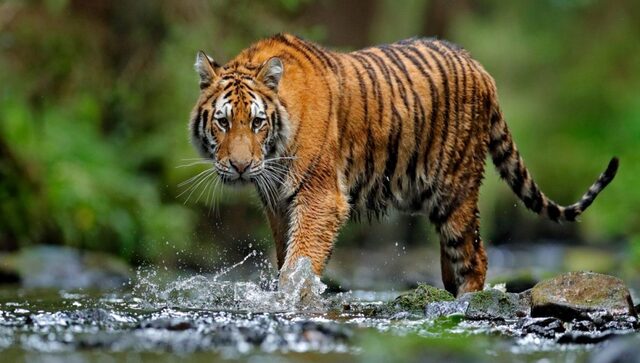On this year’s International Tiger Day, Prime Minister Narendra Modi reiterated India’s commitment to ensuring safe habitats for tigers and nurturing tiger-friendly eco-systems. “Home to over 70 per cent of the tiger population globally, we reiterate our commitment to ensuring safe habitats for our tigers and nurturing tiger-friendly eco-systems,” he said. On the occasion, the Prime Minister said that India is home to 51 tiger reserves spread across 18 states. He also informed how India “achieved the target of doubling the tiger population 4 years ahead of schedule of the St Petersburg Declaration on tiger Conservation”. If India is a success story as far as tiger conservation is concerned, Jim Corbett National Park is definitely a flagship wildlife reserve to showcase the same. Spread over 520 sq km of hills, riverine belts, marshy depressions and grasslands, it is India’s first national park. The Park was in controversy early this week after Union Minister of State for Environment, Forest and Climate Change Ashwini Kumar Choubey hinted at changing the name of Corbett National Park to Ramganga National Park. Later the Uttarakhand government clarified that it has neither received any proposal nor was in favour of changing the name. The controversy, however, was blown out of proportion. For, there was more than one occasion when its name was changed. Set up in 1935, it was initially called Hailey National Park. But between 1952 and 1956, it was briefly known as Ramganga National Park. In 1956, a year after the death of Edward James Corbett, Ramganga National Park was renamed in honour of the celebrated hunter and naturalist. Be that as it may, the fact is Corbett Tiger Reserve (CTR) has reported the highest tiger density among India’s 50 tiger reserves with 14 tigers per 100 sq km. In fact, according to a report released by the Union Environment Department, CTR has the highest tiger numbers with 252 inside the reserve and 266 using the reserve. What’s even more satisfying is the fact that tigers are evenly spread here. Dhananjai Mohan, director of Wildlife Institute of India (WII), the institution which played a key role in the country’s ‘Project Tiger’, said, “This has been possible due to good prey base, forest cover, protection and conservation efforts. Even distribution of prey base is also a key and in CTR it’s pretty evenly distributed. It’s really amazing for a state like Uttarakhand with small areas to achieve such a feat.” According to the report, CTR is followed by Nagarhole tiger reserve in Karnataka with 127 tigers, Bandipur Tiger Reserve, again in Karnataka, with 126 tigers, and Bandhavgarh and Kaziranga tiger reserves with 104 tigers each. On CTR, the report states, “A total of 5,004 tiger images were obtained from which 231 tigers were identified with tiger density estimated at 14 tigers per 100 km. Tiger population using the tiger reserve was 266, while the number of tigers present only in the tiger reserve was 231.” Increasing tiger populations is therefore synonymous with understanding the pulse of the healthy forested ecosystems. Senior scientist at WII, Qamar Qureshi, said that for a good tiger population you need a good prey base. “In the survey of the prey base in Corbett, we not only found it was good and one of the best in the country, it was also evenly distributed across the Corbett landscape. This has sustained a good population of tigers in Corbett.” According to the latest report, Corbett has a total of 32 species of ungulates, carnivores, omnivores, with chital, sambar and barking deer the most common species. There are 442 tigers in Uttarakhand according to the All India Tiger Estimation Report 2018 released by Prime Minister Narendra Modi. The National Tiger Conservation Authority (NTCA), in collaboration with state forest departments, NGOs and coordinated by WII, conducts national assessment for the ‘Status of Tigers, Co-predators, Prey and their Habitat’ every four years since 2006. The writer runs a travel company primarily operating in the Himalayan sub-region since 2000. It also caters to conservation, preservation, replenishment of natural resources & wildlife. Views expressed are personal. Read the counterargument here: Jim Corbett was a remarkable man, and deserves every honour we can bestow on him
With 14 tigers per 100 sq km, Jim Corbett National Park in Uttarakhand reports the highest tiger density among India’s 50 tiger reserves
Advertisement
End of Article


)

)
)
)
)
)
)
)
)



